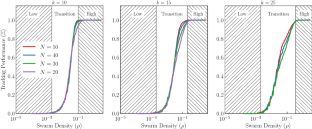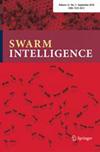群体密度对集体跟踪性能的影响
IF 2.1
4区 计算机科学
Q3 COMPUTER SCIENCE, ARTIFICIAL INTELLIGENCE
引用次数: 1
摘要
蜂群的大小如何影响它们的集体行动?尽管可以说这是一个关键参数,但没有系统和令人满意的指导原则来选择给定任务和环境所需的单位数量。即使受到实际考虑的限制,系统设计师也应该努力确定合理的群体规模。在这里,我们表明这个基本问题与选择适当的群体密度密切相关。我们分析了密度对目标跟踪任务的集体表现的影响,揭示了不同的“阶段”对应着明显不同的群体动态。我们确定了一个“过渡”阶段,在这个阶段,一个复杂的紧急集体反应出现了。有趣的是,这个过渡阶段的集体动力在探索行为和剥削行为之间表现出明显的权衡。我们表明,在任何密度下,可以通过各种方式调整探索-开发平衡以最大化系统性能,例如通过改变代理之间的连接级别。虽然密度是要考虑的主要因素,但在确定系统尺寸时,它不应该是唯一要考虑的因素。由于物理系统中存在固有的有限尺寸效应,我们确定成分的数量主要影响系统级属性,如过渡阶段的开采。这些结果表明,与其针对一组特定的任务参数学习和优化群体的行为,进一步的工作应该集中在学习自适应上,从而赋予群体在广泛的情况下能够有效运行的高度理想的特征。本文章由计算机程序翻译,如有差异,请以英文原文为准。

Effect of swarm density on collective tracking performance
How does the size of a swarm affect its collective action? Despite being arguably a key parameter, no systematic and satisfactory guiding principles exist to select the number of units required for a given task and environment. Even when limited by practical considerations, system designers should endeavor to identify what a reasonable swarm size should be. Here, we show that this fundamental question is closely linked to that of selecting an appropriate swarm density. Our analysis of the influence of density on the collective performance of a target tracking task reveals different ‘phases’ corresponding to markedly distinct group dynamics. We identify a ‘transition’ phase, in which a complex emergent collective response arises. Interestingly, the collective dynamics within this transition phase exhibit a clear trade-off between exploratory actions and exploitative ones. We show that at any density, the exploration–exploitation balance can be adjusted to maximize the system’s performance through various means, such as by changing the level of connectivity between agents. While the density is the primary factor to be considered, it should not be the sole one to be accounted for when sizing the system. Due to the inherent finite-size effects present in physical systems, we establish that the number of constituents primarily affects system-level properties such as exploitation in the transition phase. These results illustrate that instead of learning and optimizing a swarm’s behavior for a specific set of task parameters, further work should instead concentrate on learning to be adaptive, thereby endowing the swarm with the highly desirable feature of being able to operate effectively over a wide range of circumstances.
求助全文
通过发布文献求助,成功后即可免费获取论文全文。
去求助
来源期刊

Swarm Intelligence
COMPUTER SCIENCE, ARTIFICIAL INTELLIGENCE-ROBOTICS
CiteScore
5.70
自引率
11.50%
发文量
11
审稿时长
>12 weeks
期刊介绍:
Swarm Intelligence is the principal peer-reviewed publication dedicated to reporting on research
and developments in the multidisciplinary field of swarm intelligence. The journal publishes
original research articles and occasional review articles on theoretical, experimental and/or
practical aspects of swarm intelligence. All articles are published both in print and in electronic
form. There are no page charges for publication. Swarm Intelligence is published quarterly.
The field of swarm intelligence deals with systems composed of many individuals that coordinate
using decentralized control and self-organization. In particular, it focuses on the collective
behaviors that result from the local interactions of the individuals with each other and with their
environment. It is a fast-growing field that encompasses the efforts of researchers in multiple
disciplines, ranging from ethology and social science to operations research and computer
engineering.
Swarm Intelligence will report on advances in the understanding and utilization of swarm
intelligence systems, that is, systems that are based on the principles of swarm intelligence. The
following subjects are of particular interest to the journal:
• modeling and analysis of collective biological systems such as social insect colonies, flocking
vertebrates, and human crowds as well as any other swarm intelligence systems;
• application of biological swarm intelligence models to real-world problems such as distributed
computing, data clustering, graph partitioning, optimization and decision making;
• theoretical and empirical research in ant colony optimization, particle swarm optimization,
swarm robotics, and other swarm intelligence algorithms.
 求助内容:
求助内容: 应助结果提醒方式:
应助结果提醒方式:


